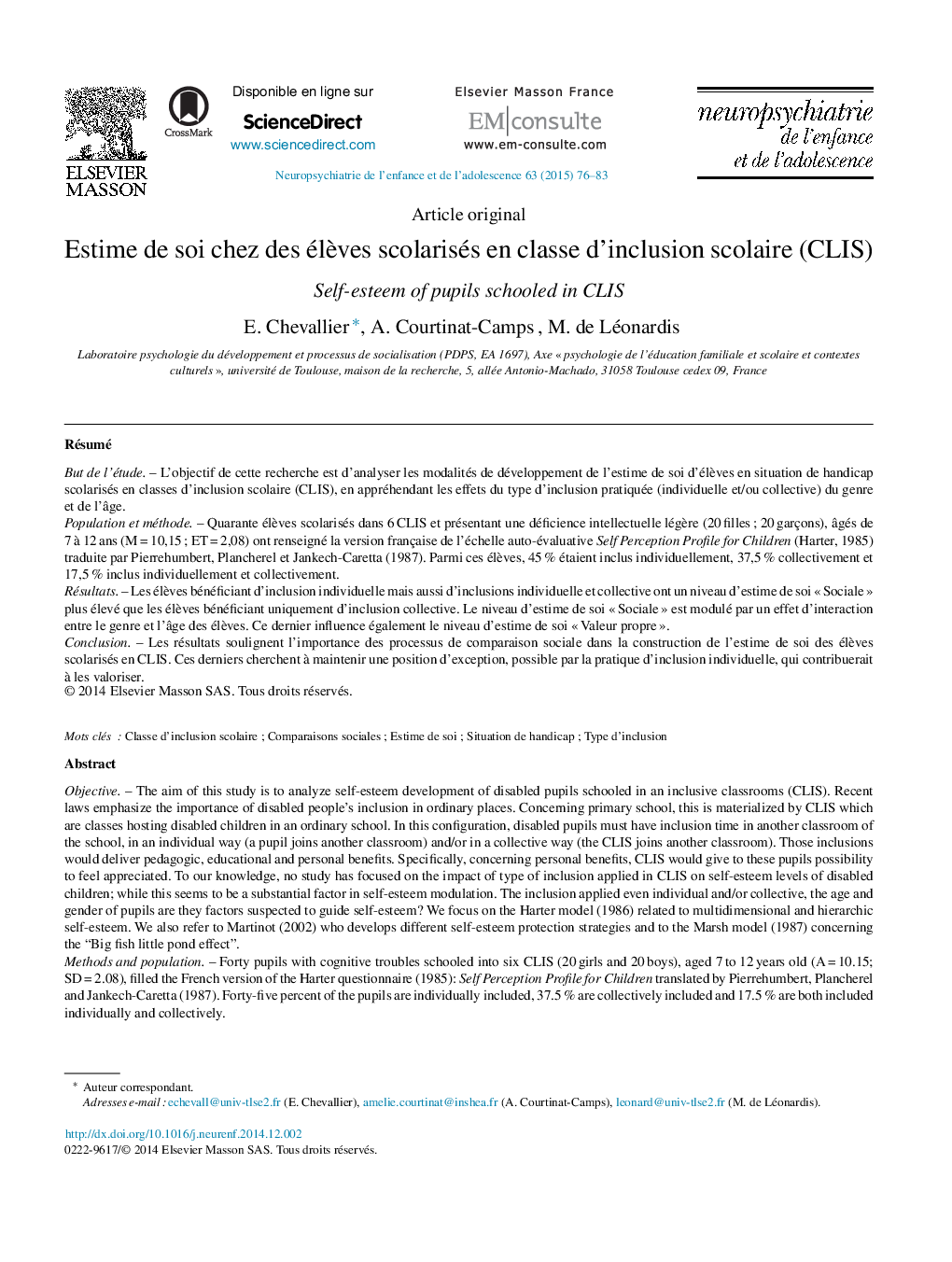| کد مقاله | کد نشریه | سال انتشار | مقاله انگلیسی | نسخه تمام متن |
|---|---|---|---|---|
| 943747 | 925556 | 2015 | 8 صفحه PDF | دانلود رایگان |

RésuméBut de l’étudeL’objectif de cette recherche est d’analyser les modalités de développement de l’estime de soi d’élèves en situation de handicap scolarisés en classes d’inclusion scolaire (CLIS), en appréhendant les effets du type d’inclusion pratiquée (individuelle et/ou collective) du genre et de l’âge.Population et méthodeQuarante élèves scolarisés dans 6 CLIS et présentant une déficience intellectuelle légère (20 filles ; 20 garçons), âgés de 7 à 12 ans (M = 10,15 ; ET = 2,08) ont renseigné la version française de l’échelle auto-évaluative Self Perception Profile for Children (Harter, 1985) traduite par Pierrehumbert, Plancherel et Jankech-Caretta (1987). Parmi ces élèves, 45 % étaient inclus individuellement, 37,5 % collectivement et 17,5 % inclus individuellement et collectivement.RésultatsLes élèves bénéficiant d’inclusion individuelle mais aussi d’inclusions individuelle et collective ont un niveau d’estime de soi « Sociale » plus élevé que les élèves bénéficiant uniquement d’inclusion collective. Le niveau d’estime de soi « Sociale » est modulé par un effet d’interaction entre le genre et l’âge des élèves. Ce dernier influence également le niveau d’estime de soi « Valeur propre ».ConclusionLes résultats soulignent l’importance des processus de comparaison sociale dans la construction de l’estime de soi des élèves scolarisés en CLIS. Ces derniers cherchent à maintenir une position d’exception, possible par la pratique d’inclusion individuelle, qui contribuerait à les valoriser.
ObjectiveThe aim of this study is to analyze self-esteem development of disabled pupils schooled in an inclusive classrooms (CLIS). Recent laws emphasize the importance of disabled people's inclusion in ordinary places. Concerning primary school, this is materialized by CLIS which are classes hosting disabled children in an ordinary school. In this configuration, disabled pupils must have inclusion time in another classroom of the school, in an individual way (a pupil joins another classroom) and/or in a collective way (the CLIS joins another classroom). Those inclusions would deliver pedagogic, educational and personal benefits. Specifically, concerning personal benefits, CLIS would give to these pupils possibility to feel appreciated. To our knowledge, no study has focused on the impact of type of inclusion applied in CLIS on self-esteem levels of disabled children; while this seems to be a substantial factor in self-esteem modulation. The inclusion applied even individual and/or collective, the age and gender of pupils are they factors suspected to guide self-esteem? We focus on the Harter model (1986) related to multidimensional and hierarchic self-esteem. We also refer to Martinot (2002) who develops different self-esteem protection strategies and to the Marsh model (1987) concerning the “Big fish little pond effect”.Methods and populationForty pupils with cognitive troubles schooled into six CLIS (20 girls and 20 boys), aged 7 to 12 years old (A = 10.15; SD = 2.08), filled the French version of the Harter questionnaire (1985): Self Perception Profile for Children translated by Pierrehumbert, Plancherel and Jankech-Caretta (1987). Forty-five percent of the pupils are individually included, 37.5 % are collectively included and 17.5 % are both included individually and collectively.ResultsOur results reveal that pupils individually included and with both inclusions have a social self-esteem higher that those who are only collectively included. Social self-esteem is modulated by the effect of interaction between age and gender. The age of the pupils is influencing the global self-esteem.ConclusionResults underline the weight of social comparison in self-esteem structure of pupils schooled in CLIS. Those who seek to maintain favored status in order to valorize themselves, which seems to be feasible by individual inclusion. Considering these results would directly influence the daily practice of professionals close to these pupils.
Journal: Neuropsychiatrie de l'Enfance et de l'Adolescence - Volume 63, Issue 2, March 2015, Pages 76–83